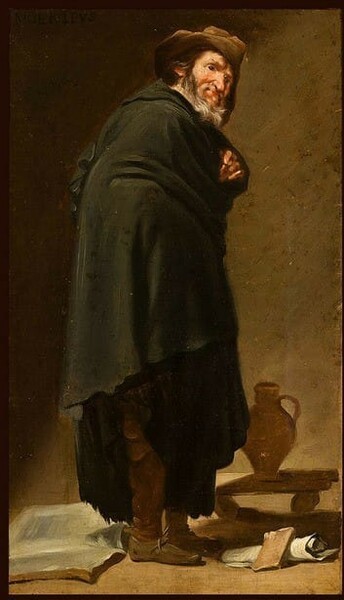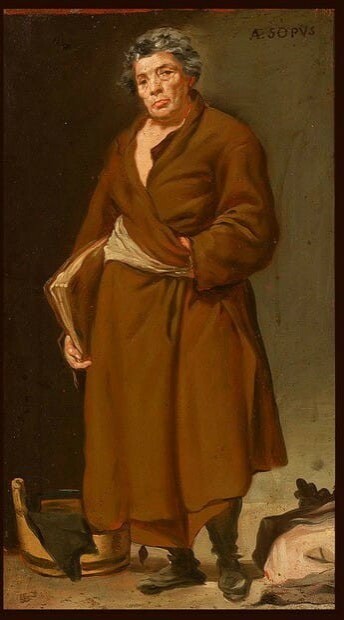- Cronología
- Ca. 1778
- Ubicación
- Museo Goya. Colección Ibercaja, Zaragoza, Spain
- Dimensiones
- 43 x 24,5 cm
- Técnica y soporte
- Oil on canvas
- Reconocimiento de la autoría de Goya
- Attributed work
- Ficha: realización/revisión
- 26 Aug 2022 / 13 Jun 2023
MOENIPPVS (upper left-hand corner)
Goya was familiar with the works of Velázquez that was in the Royal Collections and reproduced the in a series of at least seventeen engravings, called Velázquez Copies. Many of these engravings were made in 1778, such as those of Aesopus and Menippus, of which he was also able to make these oil reductions. In 1828 they were included in the collections of the Royal Academy of Fine Arts of San Luis in Zaragoza as autographs by Goya, according to the catalogue drawn up by Lalana y Llovet (not published until 1926). In 1842 they appear in the joint catalogue of the collections of the Royal Academy of Fine Arts of San Luis and the Royal Aragonese Economic Society of Friends of the Country (RSEAAP), on this occasion, and probably by mistake, as "Head of Menippus" and "Head of Aesop". In subsequent catalogues they are always listed as belonging to the RSEAAP collections. Since 2008it has been on deposit at the Goya Museum. Ibercaja Collection -Camón Aznar.
Velazquez painted the imaginary portraits of the ancient Greek philosophers Menippus and Aesopus to be part of the decoration of the Torre de la parade, along with other works of Rubens. The reductions attributed to Goya are clear evidence of this interest in internalising the work of the Sevillian master.
The Greek philosopher Menippus, born in Gadara around 270 BC, belonged to the Cynic school of philosophy. Menippus was originally a slave and thanks to his works he was able to purchase citizenship of Thebes. It is said that he was a miser and committed suicide when he loses his fortune. Menippus stands in side profile and turns his face to the viewer in a somewhat ironic attitude, covered with a robe that hides his body, revealing only his legs. At his feet are books, a roll of paper, an earthenware jar on a wooden board standing on two rollers, referring to the instability of life.
Both characters wear miserable clothes, but with notable differences of nuance. The cynical Menippus, with an elusive gesture, seems to express the resentment of his frustrated greed. While the fabulist Aesopus, looks frankly at the audience, confirming with his humble appearance the cliché of the stoic philosopher detached from material goods.
The testamentary estateof Francisco Bayeu acquired by Chopinot in 1796 also included copies of Velázquez's Aesop and Menipo by Ramón Bayeu.
-
Zaragoza1981cat. 89
-
San Sebastian1989cat. 53
-
Madrid2017
-
ZaragozaImprenta de M. Peiró1842p. 16
-
Zaragoza1926p. 44
-
Zaragoza1981pp. 92-96
-
Zaragoza1981p. 89

